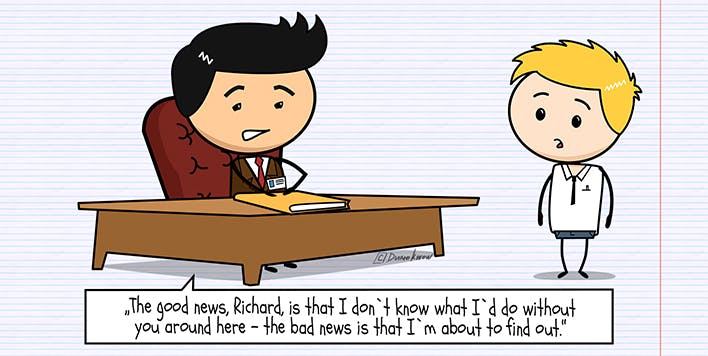The Best Ways to Deliver a Bad News To Someone
Delivering bad news to someone can be a tricky task. However, if handled carefully it can save from blunders that could ruin relationships.
Recently I came across this post where a person claimed to have ordered samosas and tea, however, the tea wasn't delivered. The concerned individual called the company's Customer Care, and this is how they responded.

Not all customer service representatives respond in this manner. By abandoning the mechanical approach of answering and incorporating empathy into your discussions, you may establish stronger relationships.
They say the pen is mightier than the sword. This is because the power of words is limitless. Each word you speak or write can either build peace or spark conflicts. You know what it is that you need.
How many times have you had to break the terrible news to someone? Have you felt the jitter in your stomach before taking the plunge? How has the person opposite reacted on hearing it? You don't have control over the news, but you do have power over how you present it!
Before we get into the ways you should deliver bad news, let's first understand what it is that you should avoid doing.
DON'Ts of Delivering Bad News
- DO NOT create a sense of helplessness.
- DO NOT show indifference.
- DO NOT repeat a point.
- DO NOT overpromise.
How To Deliver Bad News Effectively
The amount to which negative news might influence the listener varies depending on the method of communication. Here are a few pointers to keep in mind regardless of the medium of delivery.

1. Come to terms with the bad news yourself
First and foremost, understand that if you are the one delivering the terrible news, you should be emotionally stable. Your listener might be having a rough day already. Your delivery of the news will almost certainly ruin their day. There's a good possibility they'll be overwhelmed by unpleasant feelings in such scenarios. You must be able to control yourself and avoid any type of fierce discussion. You can picture the event in many ways and plan your response to the worst-case scenario.
2. Show clarity of speech
Assert yourself. Any delay in message transmission will further exacerbate the situation. Do not beat around the bush. Be as honest as possible and include explanations for the occurrence of the incidence, if any. Answering their unasked questions will help settle in the news faster. Say what you mean, mean what you say and don't be mean when you say it. Avoid being defensive in such times. For example, if you fire someone, they have a right to know why. If you just let them go without explaining why, they'll be puzzled, unhappy, and have a negative image of you and the organization.
3. Be genuine and empathetic
It is normal to be frustrated if one does not receive the desired reaction. Consider occasions when you have delivered difficult news to a friend or family member and replay the event. This will assist you in projecting a kind and understanding demeanour. NOTHING should be sugar-coated when it comes to terrible news. However, make an effort to connect with them on a deeper level. I don't think I need to emphasise the importance of "placing yourself in the shoes of the listener." Many situations may be de-escalated by allowing the client to express their emotions without defending, recognizing, and supporting their sentiments. You can use sentences like:
- I realize that this whole thing is frustrating for you. Please don't worry. I'll get to the bottom of this.
- I do understand how you must be troubled by this. I would have felt the same had I been in your place.
4. Be transparent and take responsibility
Give consumers, workers, or anyone else involved the impression that the problem is being handled with openness, responsibility, and accountability. Prepare ahead of time by doing your study and being prepared to address any inquiries that may emerge as a result of the news. Give accurate responses. Be forthright and truthful with the news. Because we are all human, conduct human interactions and be honest when you have bad news.
5. Offer alternatives
When you make a mistake or encounter a problem that is your fault, take accountability for it. Then get your ego out of the way and sincerely apologize. Most people will be ready to work together without anger to solve a problem if you apologise and then demonstrate your desire to make things right by addressing the problem or explaining what you are doing for future progress. If you have to deliver bad news, maybe it doesn't have to be the end of the world. Do you have a strategy in place to handle or fix the situation? If this is the case, remember it and offer to share it with the other person or group after you have delivered the awful news. You will exhibit a desire to work through the difficulty as well as the capacity to think forward and plan by doing so. If the person receiving the bad news is a critical client or your employer, forethought might be beneficial to your future. However, be sure you don't overpromise or leave the listener with options. Avoid urging them to focus on the good because this is a sensitive subject that might backfire.
Medium of Communication

All the above tips are common to all the media of communication. Apart from them, here are a few things that you need to keep in mind when communicating via different media.
1. By Email
- Be professional throughout. Do not let your emotions flow through your words.
- Be polite and extremely honest.
- Keep your sentences below 20 words.
2. By Chat
- Call the customer/recipient by name and use personal pronouns.
- Since this is a chat message, keep it short and avoid using acronyms.
- Write in a friendly tone.
3. By Call
- Be confident and speak slowly.
- Use a casual, friendly tone.
- Avoid negative words and situations that might end up in heated conversations.
- Speak with finality
4. Face-to-Face
- Be sensitive to the physical location. Do not raise your voice in public.
- Make proper eye contact. It gives confidence to both the speaker and listener.
- Maintain a proper posture.
- Your hands should be visible.
Conclusion
The ability to communicate effectively during a crisis helps instill confidence, ease fears, and help others prepare for change even when you don’t have all the answers. Use your experiences as a lesson and help others learn from your good and bad pointers.
How do you prefer to communicate a piece of bad news? Do share it in the comment section. If you found this article helpful, please share it with your connections and leave feedback.